Argie 15
|
|
Hi folks, I am new here but have some new mates from the DCA who have introduced me to HBBR.
I'm in Brisbane (upside down to where most of you are). I wanted to build a boat for some years, built a couple of RC models then decided to build something real during the Covid lockdown last year. Here is Eadie Mae with me, my son and Dusty the Dog....  Eadie Mae is a bitzer. She started as a set of Sabot plans, but I extended her to a 10 foot x 4 foot pram. I added a pointy end as an after thought, plus a bunch of other fixes, re-designs, re-fits but at the end of the day she has some construction flaws and was far too small for my 6'2" frame plus the odd passenger. I got to the point of saying "no more money for Eadie Mae". So I now join the club of those who decided to start again (but of course with a whole bunch of new found skills). I will re-use much of the rigging and other major parts so it is not a complete loss. In fact not a loss at all. It gave me experience. My wifey is very supportive and says it was something I enjoyed doing so she'd rather me do it properly and be safe than keep patching up the old one. So I start from ground zero right now, and the saga will be documented here and I will welcome all comments and opinions if you see me straying from the path. So.....what is it I want. Firstly an open cruising dinghy capable of coastal cruising (Moreton Bay is well protected from big swells but can put up some choppy conditions at times). Able to sleep aboard (single hand but with an offsider on occasion). Flattish bottom to take the ground at low tide. Pivoting centreboard for the shallow mud flats at the exit of my creek. At this point I only need the hull. Everything else I have well sorted from Eadie Mae - traditional balance lug rig, kickup rudder, small electric outboard for boat ramp manoeuvers, etc, etc. I might install a mizzen because the rig I have is going to be "small" for a larger boat. I've done a lot of brainstorming over the past months that this change has been brewing in my head and narrowed it down to the Argie 15 or a 14 foot American sharpie. For various reasons I have decided to go with the Argie 15 and I will build the base hull as per plan but I very much doubt anything else will be standard after that. I found some photos and sketches of some cut out panels and put them on stiff paper for a bit of a preview. Here is a 1:10 scale model including a 1:10 scale model of me...  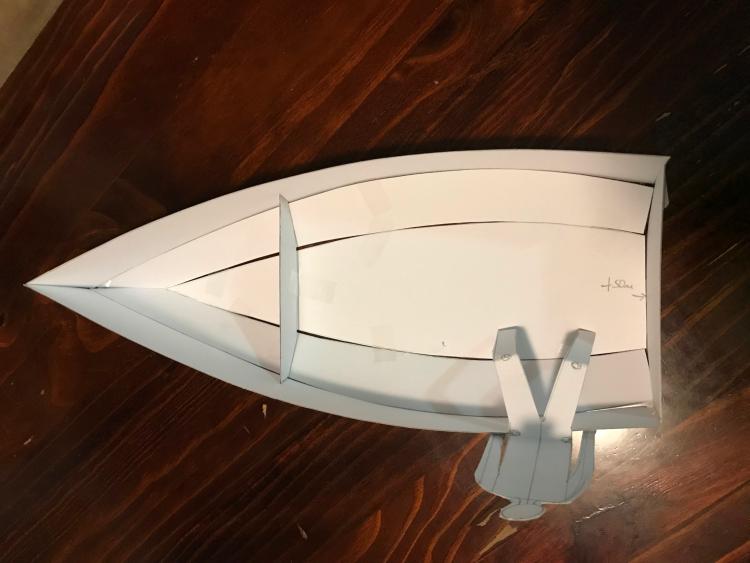 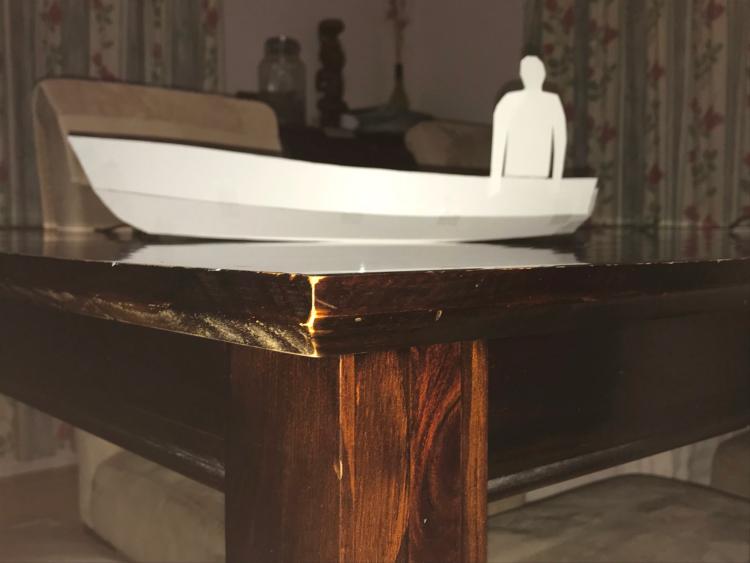 I'm pretty happy with this. I think I will cut the upper side panels generously to build in a little more freeboard but other than that I think it will do the business. Plans are very cheap......I'll keep you posted. Jason |
|
|
Hi Jason,
Welcome to the club. For the benefit of those not familiar with the design here's a very nice video of one sailing in Scandinavia. I like the simplicity of the lug sail as opposed to the sloop version. Look forward to following your build. https://youtu.be/gVSgyqCyQSY |
|
|
It's a compelling design, but more freeboard at the rear is needed.
Checkout this video just before 10mins. The skipper tacks then a gust hits. You can see she takes on water. https://youtu.be/6FYnwURh56A The water is flat, no white horses so I was very surprised she took on water. Paul |
|
|
He is sat further back than I would have expected, perhaps not the boats fault.
Steve 
|
|
|
Thanks Paul, yes I fully intend to cut the upper full panels fuller to give me a bit more free board. According to my scale model the lowest freeboard is about 400mm after taking off the LWL draft. I'm quite tall so it will make sitting more comfortable as I will have a bit more to lean on. I just need to re-organise the patterns to make best use of the plywood. That guy does like to sit in the back and point the nose up in the air. I'll be using ballast to keep it in trim.
It looks like I can get a couple of types of marine ply. Oukume/Gaboon and some sort of hardwood species that the guy wasn't sure about; pacific maple he thinks - some sort of pinkish colour. The hardwood is nearly double the price. I'm not using big box store wood this time around because it was quite variable in quality. I'll be glassing the entire outside and the inside seams so I think Gaboon is fine. I've seen plenty of people use it for boats. Jason |
|
|
Does anyone have experience with plywood? Ah-hem.....Mr Waite perhaps?
I went past the big box store near me just to see and they have a pretty good looking mixed hardwood marine ply. The sheets look nice and consistent. Here is the cross section. 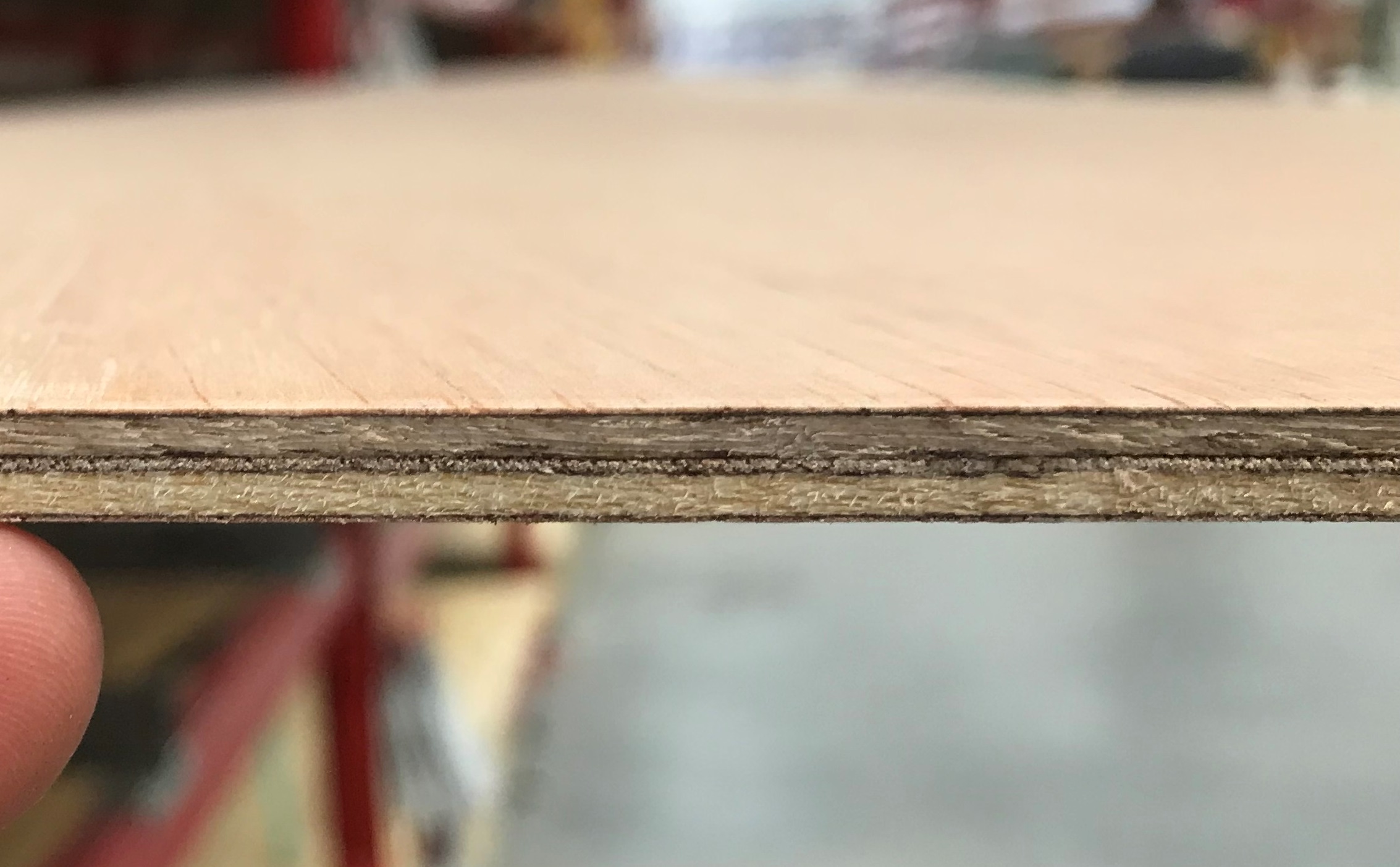 And the surface 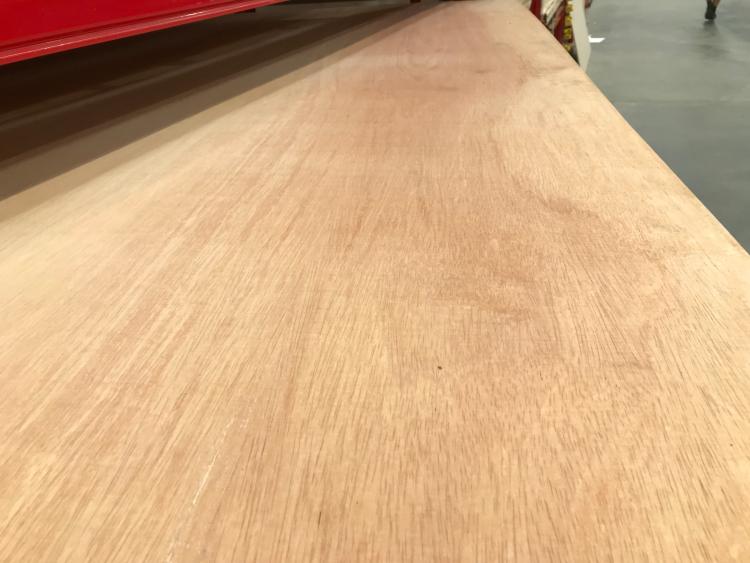 It is certified to BS1088 and the certificate number is current so it looks like the real deal. The sheets are allegedly 16kg each so that means a density of 895kg/cubic metre so it's pretty dense compared to Gaboon which is more like 500. That would give me good impact resistance? Yes? The scale model did not seem to torture the panels that much. So I wonder if hardwood ply will give me a better result for a cruising dinghy. Jason |
|
|
While CW is busy getting the DCA organised (some chance) I will fire right in and say I wouldn't touch that stuff. Firstly, 6mm ply should have five equal laminates. This stuff has paper thin exterior laminates, for show, then two thick layers of dubious quality and something in the middle. Any epoxy or other coating on the outside will only permeate as far as the first glue line, don't believe anyone who talks about saturating ply with epoxy, I would be worried this stuff would start to delaminate before the glue went off. I've been there, I'm not going again. The quality of BS 1088, Marine Grade ply varies enormously in terms of timber and durability. The stamp pretty much says that the glue is waterproof and there are no voids in the laminates. Exterior grade WBP ply can be every bit as good, especially if the yard will let you pick through the stack and check for voids. My local timber merchant often has good quality Gaboon WBP which is every bit as good as Robbins Elite, the Go-To supplier in the UK. Go for Gaboon if you can get it, don't worry too much if it isn't stamped marine so long as it is exterior grade WBP and free of voids. Others may tell of their success with Birch and other species. Regards Graham Sent from my Xperia by Sony smartphone ---- Jason Mayer [via UK HBBR Forum] wrote ---- Does anyone have experience with plywood? Ah-hem.....Mr Waite perhaps? I went past the big box store near me just to see and they have a pretty good looking mixed hardwood marine ply. The sheets look nice and consistent. Here is the cross section.  And the surface  It is certified to BS1088 and the certificate number is current so it looks like the real deal. The sheets are allegedly 16kg each so that means a density of 895kg/cubic metre so it's pretty dense compared to Gaboon which is more like 500. That would give me good impact resistance? Yes? The scale model did not seem to torture the panels that much. So I wonder if hardwood ply will give me a better result for a cruising dinghy. Jason If you reply to this email, your message will be added to the discussion below:
http://uk-hbbr-forum.967333.n3.nabble.com/Argie-15-tp4031943p4031948.html
To start a new topic under Builds in Progress, email [hidden email]
To unsubscribe from UK HBBR Forum, click here. NAML |
|
|
Thanks G.....you saved me from doing something dumb. If you ever visit Katie Beardie's sister look me up and I will shout you many pints at the craft beer bar near the boat ramp!
I will take a look at the Gaboon ply that's available next week and see if it's better quality. Patience Mr Mayer....patience..... Jason |
|
|
Update:
I got the plans ($50 cheap). I upgraded from dodgy paper model to exact 1:10 scale balsa model with all dimensions taken from the actual plans. It gave me a chance to practice the lofting. I added 100mm additional freeboard. What that tells me is that I will need some upside down knees amidships on the middle seat to provide some additional support to the sheer which is now 100mm higher than it was (the sheer on the model is a bit flexy in the middle). Admittedly I only have 3 bulkheads in place and no seat tops. Or I can beef up the inner and outer gunwales. I like the lines and it looks like a much better fit. What do you reckon? The LWL is about 1cm above the table (part way up the lower panel). 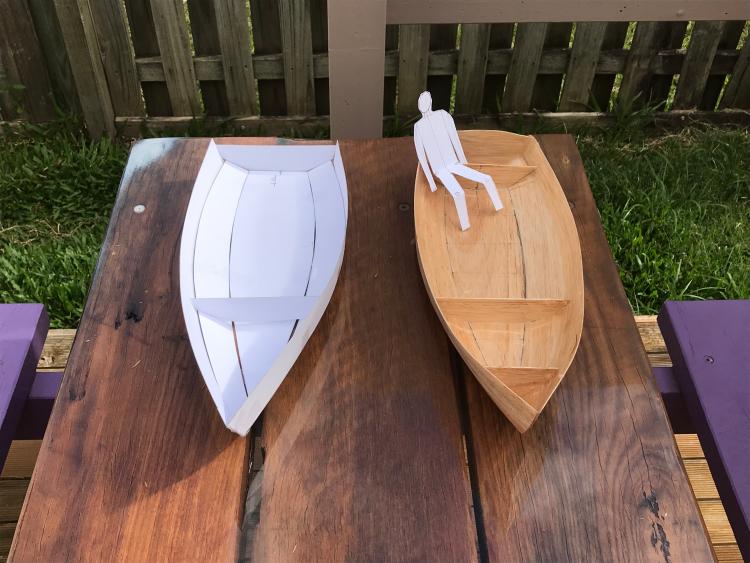 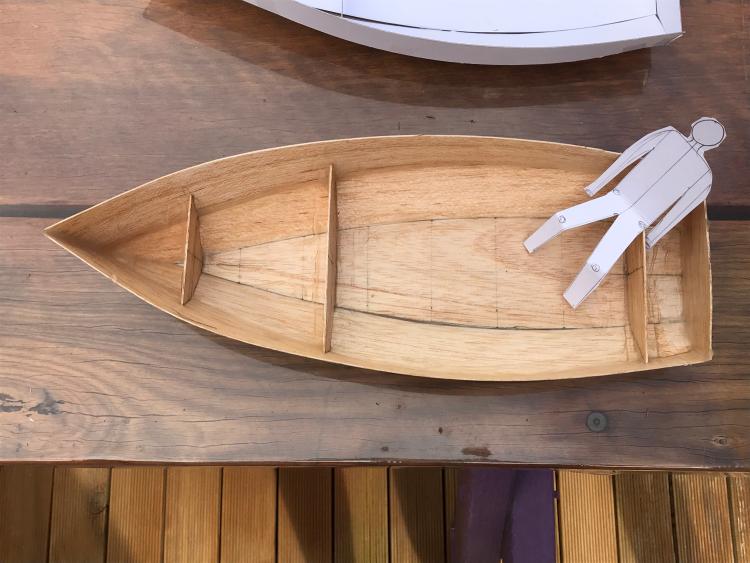  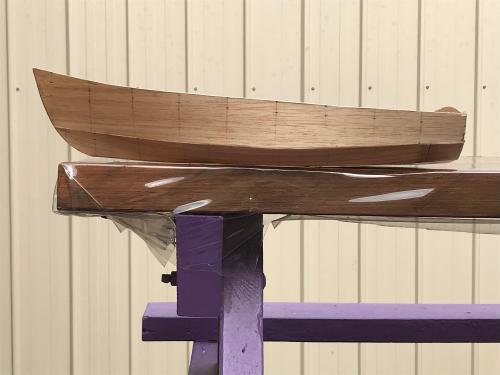 |
|
|
Looks good to me.
Steve 
|
|
|
Looking good there Jason.
The other way to add a bit of effective freeboard without increasing the actual depth of plank is to add a small side deck and coaming. The boat can heel a bit further before taking in water, the coaming can be comfortable to lean against, and the side deck somewhere to perch out on with the addition of a raised seat for comfort. I've borrowed this photo from the Selway Fisher web site, which shows the general idea.  Regards Graham. |
|
|
In reply to this post by Port-Na-Storm
Plywood update.
So you know I have bypassed the dodgy ply at the big box store. I started hunting around the professional ply merchants here in Brisbane. I found a supplier of "proper" Gaboon ply sheets. Guess what....BS1088 certified....Yay....hang on....what?  That's worse than the first lot. So I started trawling the forums and found a thread from a bunch of Aussies complaining about the crappy ply we get over here. Then a fellow from a preeminent wooden boat builder in Tasmania pops up and goes through all his experiences. He now only uses Joubert plywood from France. It comes with a traceable Lloyds certificate for use in marine construction rather than a smudged ink stamp that is illegible and most of the time just "made up". He doesn't sell the stuff but imports his own supplies. If you wanted to wait 6 weeks he'll add your order to his order. Then it's 3 months delivery. Alright for him, he keeps a stock. Anyway long story, but I found a merchant here in Brisbane who does stock the Joubert ply. I have seen photos, it is genuine 5 ply with even laminate thicknesses. Here is an example. 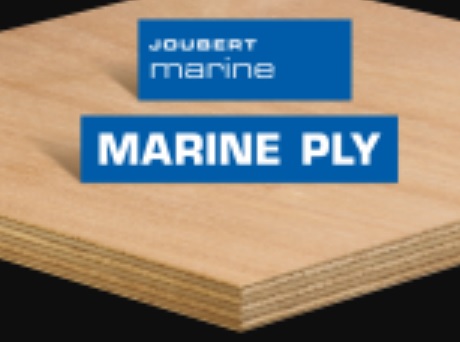 The price is eye watering ($40 more per sheet than the crap stuff) but the Tasmanian boat builders have a reputation for knowing their stuff so the cost will be a distant memory once I have a wonderful boat that I know will last a lifetime. Picking it up Thursday. Jason |
|
|
I agree with the sentiments' in your last paragraph. I built my first boat using cheap plywood and have suffered ever since. Not only has it caused a lot of problems but the cost and hassle of sorting them out far outweighs the initial higher cost. Good luck with your build.
Chris A. |
|
|
That's better. You can always tell by the price. Proper marine ply is always alot more expensive. - Even ply with maybe a good veneer on one side but always a balancer on the other. It does pay in the end. Good luck and take care.
Richard |
|
|
https://boatcraft.com.au/informationpages/imported_plywood_2011_update.htm This is what the Pacific Boat Craft website in Australia says about marine ply. I think much the same can be said about the UK despite the legislation. Caveat Emptor Rodney, 😁 Sent from my Xperia by Sony smartphone ---- inwe [via UK HBBR Forum] wrote ---- That's better. You can always tell by the price. Proper marine ply is always alot more expensive. - Even ply with maybe a good veneer on one side but always a balancer on the other. It does pay in the end. Good luck and take care. Richard If you reply to this email, your message will be added to the discussion below:
http://uk-hbbr-forum.967333.n3.nabble.com/Argie-15-tp4031943p4031959.html
To start a new topic under Builds in Progress, email [hidden email]
To unsubscribe from UK HBBR Forum, click here. NAML |
|
|
In reply to this post by inwe
As Richard alluded, a joint is only as strong as the glue that holds the top ply layer.
Weight is a good factor, holding a piece of good ply you notice the weight. Trying to bend a strip of 6mm gives a lot away, the good stuff is stiff but the poor stuff bends and snaps easily. I expect NZ has a good variety of trees to make really good ply? Top tip: reclaimed Oak kitchen doors (out of fashion with my daughters generation) are a great source of 20mm Oak strip. Skips are full of them. |
|
|
Thanks everyone. Yes the stuff I have found looks like the European version discussed in Graham's post above. I need to eyeball it yet but they are specifically advertising it as Joubert from France with the Lloyds of London certificates.
Jason |
|
|
In reply to this post by Jason Mayer
Jason,
To my eye, the rear half of the sheer line could be more seaworthy with a traditional gentle curve up to the transom. I made a wobbly curve on my phone editor to demonstrate: 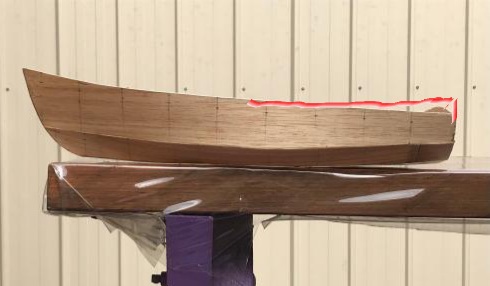 That puts the transom about 150mm to 200mm higher, give or take. Compare with Polly Wee. Others may have a different view. She could face some big OZ sized rollers! Paul |
|
|
This post was updated on .
In reply to this post by Jason Mayer
Apologies for being AWOL, Jason
For some reason Nabble HBBR, (but not Nabble DCA), have stopped sending me email digests. Not only have they stopped, but I cannot find it in 'My Preferences' to kick a little butt, either. Paulie - help?? And while I have your attention; I am going to be as arrogant as ever and explain what I reckon went wrong with the Argie 15 taking water. Bear in mind that this is a forum for things to be chewed over and I did not start the discussion; this is merely an opinion by way of response. The gentleman is acting the Plonk-bottomed Cord-wrangler; it's actually quite instructive. (Not a Cordwangler - https://www.youtube.com/watch?v=99IitWYZ0aU ) That is, he appears to be a cruising man, cushion under bum, with a short tiller and stubby extension. I am not just being a clever-clogs; this is some seven decades of hard gleaned experience. 1. A dinghy is extremely sensitive to its 'pitch'; the fore and aft angle at which it goes through the water. As a general rule - a. The lighter the weather the further forward you should sit. Why; because it lifts the greater hull area under the stern out of the water, reducing drag. b. Going to weather also works best sitting forward. Why; because it pushes the bow down, increasing the pressure under the lee-bow and along with the decreased lateral resistance on the raised aft sections tends to increase weather helm, both holding the boat up to windward. c. Rolling the boat to leeward (particularly in light weather) also increases the lee bow effect and reduces the submeregd surface area, therefore drag. Further, it ensures that the sail is already aerofoil shaped by gravity so any wind hitting it does not have to push it into shape first. d. I am not too much impressed with the idea of a baggier sail for light weather; it has never really worked for me, so I set the sail up quite flat, regardless of the conditions and don't even have a clew outhaul. If you are getting down to the merest whispers, the sail needs to be flat anyway, as the air doesn't then have to find its way into the sail, but anything that comes your way has an immediate effect. e. As you come off the wind in stronger conditions, then it pays to move back in the boat. This is only to lift the bow and encourage the boat to plane if it will. Do not automatically go right aft, as stern-down drag actually retards the hull, delaying planing as the boat has to climb up-hill, out of its own hole. f. When running in Polly Wee, I have to sit well aft to raise her forefoot which otherwise tends to catch in the wave ahead and end in catastrophe. This is inclined to sink the smallish transom and I can hear the turbulence burbling behind me, but I didn't want a bigger one for fear of being broached by a following sea. Much of the time, I would like to sit a little further forward, but because of the longish tiller, which enables me to sit forward as required, I get in the way of swinging the helm far enough to be effective. You can't have everything; here are a couple of images to show how I change position - 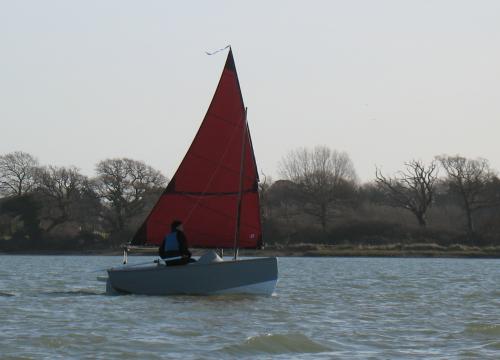 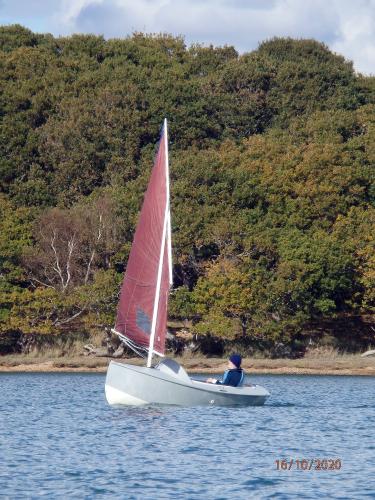 I can sit in the sternsheets, where the tiller can swing enough infront of me and my weight counteracts the pressure of the big sail well forward, pushing the bow down; this is favourite but the drag created is not ideal. Back to our Argie helmsman. 2. From his self-enforced location aft, he struggles with a mainsheet jammer on a string, (the short strop under the block; if you want to shorten the purchases on a mainsheet, arrange such strops between the blocks and the boom, keeping the bulky rope nearer the cockpit sole and away from trailing in the sea and such). Note he has to let go of everything else while he hauls the sheet in and jams it. If you are going to use a jammer, mount it firmly, so that it functions singlehanded on (the aft end of) the centreboard case, on the hog at floorboard level, or on a small tower if you want something else to attach a toe strap to and trip over. I have chosen to use the Laser system whereby the sheet runs on an aft (rope) horse, is led forward along the boom and down to a horizontally rotating jammer on a removable pylon that lifts it clear of the handle on the centreboard case as that arcs aft to lower - 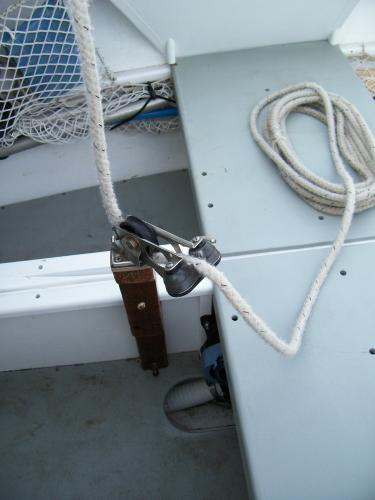
If the rope horse is too far aft the sheet tends to wrap around a quarter at deck level on gybing - with ghastly consequences, so I have moved it forward to the front of the sterndeck, which itself is there not only to shed water, but to prevent me sitting too far aft. 3. His next problem is that he has to squeeze himself between the tiller and the mainsheet on tacking (From minute 9:30 on), and then the jib sheet fouls on his mainsheet while being backed, so he has to take it forward round the mainsheet part way through the manoeuvre. He would find it a lot easier if he rigged the mainsheet aft, or to properly 'central'.... All these points may sound like mere trifles, but you'd be amazed how much faster you go if you get them all correct, versus those roosting at their tillers. All that string fighting for attention makes one unstayed balance lug look appealingly naked. But we were discussing taking water, yes? I think you're being a smidge unfair Paulie; she only took a cupful or two and it was, as you said a 'gust', implying it was an unheralded flurry on an otherwise 'light' day, so there wouldn't be time for any white horses to appear and even if there were, they wouldn't be very visible looking into the sun at the backs of the waves. You haven't lived until you've taken a dollop over the lee rail. And having said that; I agree with you and Jason that for cruisng purposes she would benefit from a little more freeboard, though making the seat a side-deck would achieve much the same thing. Chris |
|
|
In reply to this post by Paul H (admin)
Thanks Paul yes I agree. I’ll make that change when I loft the panels. In fact I have seen photos of other Argies and they look like your sketch so I wonder if other people actually do change the plans. My scale model was cut precisely from the plans except I added an even 100mm (full scale) to the sheer. So the official plan seems to have it sitting down at the back. Easy fixed. Thanks for the suggestion.
My model also has a mistake in that the transom should be raked. I glued it in vertical accidentally. Chris, I agree with you although the explanation floating around in my head was that he'd eaten a few too many cakes and then sat too far back. I guess I was on the right track. Jason |
| Free forum by Nabble | Edit this page |

